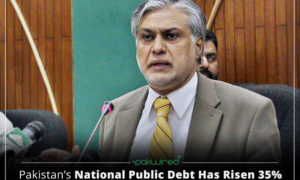The volume of net public debt as on Sept 30, 2016 has been Rs18,277.6 trillion, in contrast to the total public debt at Rs13.48 trillion at the end of fiscal year 2012-13 – almost three years ago.
In a fiery question answer session in the National Assembly last week, the ministry of finance revealed that Pakistan’s net public debt has crossed the Rs18.28 trillion mark. This is about 35pc rise in the national public debt during the tenure of the current political regime.
Most significant contribution to this rise in net public debt has been by means of an almost 40pc rise in domestic debt during the said period. This implies that the domestic debt rose from Rs8.686tr at the end of 2013 to Rs12.14tr at the end of the first quarter of the current fiscal year (FY 2016-17).
Covering the same period, the ministry informed the house, foreign debt underwent an increase of 28pc and rose from Rs4.796tr in 2013 to Rs6.14tr on Sept 30, 2016.
Briefing the house about the background of such overwhelming debt rise, ministry stated that public debt has been mainly obtained to compensate for the fiscal deficit and that it had been approved by the Parliament. To supplement domestic avenues which are required to keep the economic activity, some financing had to be availed in the form of external loans. The ministry maintained it to be essential for developing the country’s infrastructure base.
The house was told:
“These loans were obtained for financing of projects of national importance, budgetary and balance of payments support, earthquake and floods, rehabilitation assistance and import of urea and crude oil”
In government’s defense, the ministry of finance shared that unlike the previous years, the national economy continued to keep a growth momentum over four per cent for real gross domestic product (GDP) for three years in a row, reaching a growth rate of 4.71pc in 2015-16, which is the highest in eight years.
In addition to this, the ministry expressed to have successfully lessened the fiscal deficit from 8.2pc of the GDP in 2012-13 to 4.6pc in 2015-16. The target, the house was told, is to further curtail the budget deficit at 3.8pc of GDP at the end of the current fiscal year, and restrict it to 3.5pc by FY 2018-19.
Another feather in government’s cap that the ministry proudly flaunted, has been leading the tax-to-GDP ratio to increase from 9.8pc in 2012-13 to 12.4pc of the GDP in 2015-16. This tax-to-GDP ratio rise has been on top of the surge of public sector investments from Rs348bn in 2013 to Rs800bn this year.


